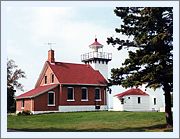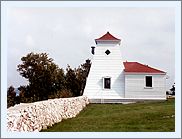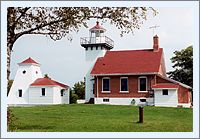|
Historical
Information

As was the case with most areas along the shores of the
Great Lakes, Sturgeon Bay gained its initial prosperity through the
lumbering of the seemingly endless forests that surround the lake.
However, with the declining availability of lumber resulting from
clear-cutting, the area was under a metamorphosis as a shipbuilding
center. With vessels required to sail completely around the peninsula
and through Death's Door to make entry into the port of Green Bay and
the boatyards in Sturgeon Bay, a group of local business interests under
the urging of Joseph Harris, Sr. the editor of the Door County Advocate,
conceived the idea of excavating a canal through the swampy ground
between Lake Michigan and Sturgeon Bay to drastically shorten the route
of navigation. The Sturgeon Bay and Lake Michigan Ship Canal and Harbor
Company was formed, shares were sold and excavation began in 1872.
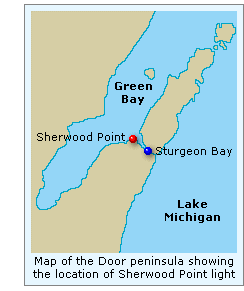 By 1880, work had progressed to the point that small
vessels were able to negotiate the new cut, and with opening for larger
vessels planned for 1882, the Company realized that an aid to navigation
was needed to guide vessels into the western end of the waterway. An
agreement was reached with the Lighthouse Board whereby the Board agreed
to establish a light station if the company would purchase the necessary
land and deed it over to the Federal Government. In March 1880, a site
atop a thirty-foot limestone bluff known as Sherwood Point was selected
for the station, a 1.1-acre site surveyed, and negotiations were
underway to obtain clear title for the site. While Congress appropriated
the $12,000 for the station's construction on March 31, 188, the matter
of title to the site was not resolved until 188, and thus construction
did not begin until May 14, when the lighthouse tender WARRINGTON
anchored off Sawyers Harbor as a working party of 20 men labored to
lighter all of the building materials to shore. By 1880, work had progressed to the point that small
vessels were able to negotiate the new cut, and with opening for larger
vessels planned for 1882, the Company realized that an aid to navigation
was needed to guide vessels into the western end of the waterway. An
agreement was reached with the Lighthouse Board whereby the Board agreed
to establish a light station if the company would purchase the necessary
land and deed it over to the Federal Government. In March 1880, a site
atop a thirty-foot limestone bluff known as Sherwood Point was selected
for the station, a 1.1-acre site surveyed, and negotiations were
underway to obtain clear title for the site. While Congress appropriated
the $12,000 for the station's construction on March 31, 188, the matter
of title to the site was not resolved until 188, and thus construction
did not begin until May 14, when the lighthouse tender WARRINGTON
anchored off Sawyers Harbor as a working party of 20 men labored to
lighter all of the building materials to shore.
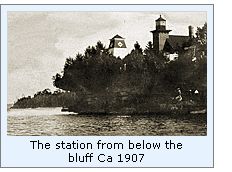 After clearing and grading a road from Sawyers Harbor
to the station site, the building materials and supplies were
transported to the work site by team, and work began in earnest. A
cellar was blasted into the rock, which the masons lined with rubble
stone gleaned from the site after the blasting process. Beneath what
would end up being the kitchen end of the cellar, a 1,500-gallon brick
cistern was erected to hold drinking water, its interior surfaces lined
with a plaster coating. By June 30, four courses of red brick had been
laid atop the rubble stone foundation walls, a brick-lined drain had
been laid leading from the cellar to the bluff face, and a 4"
diameter well had been drilled through the rock to a depth of 42 feet,
and piped into the cistern in the cellar. After clearing and grading a road from Sawyers Harbor
to the station site, the building materials and supplies were
transported to the work site by team, and work began in earnest. A
cellar was blasted into the rock, which the masons lined with rubble
stone gleaned from the site after the blasting process. Beneath what
would end up being the kitchen end of the cellar, a 1,500-gallon brick
cistern was erected to hold drinking water, its interior surfaces lined
with a plaster coating. By June 30, four courses of red brick had been
laid atop the rubble stone foundation walls, a brick-lined drain had
been laid leading from the cellar to the bluff face, and a 4"
diameter well had been drilled through the rock to a depth of 42 feet,
and piped into the cistern in the cellar.
The structure that took shape over the remainder of
the summer was the first of a design that would be duplicated the
following year at Little Traverse and Baraga. Taking the form of a two
and a half story red brick dwelling containing six rooms with a square
tower 8' 5" in plan with walls 12" in thickness integrated
into the center of the north gable end. A double flight of wooden stairs
within the tower lead from the first floor to an open landing on the
second floor, and served as the only connection between the two floors.
To tower was capped with a square cast iron gallery floor, on which a
decagonal prefabricated cast iron lantern seven feet in diameter was
centered. Access to the lantern was provided by a steep set of stairs
leading from the second floor landing to a scuttle in the lantern floor
equipped with a cast iron door. The lantern was in turn capped by a roof
consisting of ten prefabricated cast iron sections, and crowned with a
cast iron ventilator ball with a brass lightning spike tipped with
platinum. A ¾" diameter wrought iron lightning conductor was
attached to the lower side of the iron lantern deck, and lead down the
exterior of the brick tower through I bolts to a ground rod sunk into
the bedrock twelve feet away from the tower. Bolted to the center of the
lantern floor, a cast iron pedestal served as a mounting base for the
station's illuminating apparatus.
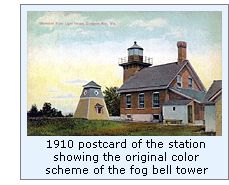 The district Lampist, Mr. Crump, arrived at the
station, and carefully uncrated the station's new Fourth
Order Fresnel lens which had been manufactured in France and
shipped to the station by way of the central depot in Staten Island and
the district depot in Detroit. After the components were carefully
carried into the lantern, the lens was assembled atop the pedestal.
Designed to exhibit fixed white characteristic with a red flash every
sixty seconds, the lens was outfitted with an external ring outfitted
with prismatic ruby colored glass flash panels which rotated around the
outside the lens. Power for rotating the three ruby panels was provided
by a fan regulated clockwork mechanism connected to the ring by a series
of gears. A steel cable 22 feet in length was wound around a drum within
the clockworks, with the cable routed through the lantern floor to a
vertical shaft within the west wall of the tower, and a heavy weight
attached to the lower end of the cable. This weight slowly dropped down
within the shaft, it turned the drum, thereby rotating the panels
attached to the outer ring. By virtue of the station's location atop the
bluff, the lens sat at a focal plane of 60 feet above lake level, and
would be visible for a distance of 15 miles in clear weather. The district Lampist, Mr. Crump, arrived at the
station, and carefully uncrated the station's new Fourth
Order Fresnel lens which had been manufactured in France and
shipped to the station by way of the central depot in Staten Island and
the district depot in Detroit. After the components were carefully
carried into the lantern, the lens was assembled atop the pedestal.
Designed to exhibit fixed white characteristic with a red flash every
sixty seconds, the lens was outfitted with an external ring outfitted
with prismatic ruby colored glass flash panels which rotated around the
outside the lens. Power for rotating the three ruby panels was provided
by a fan regulated clockwork mechanism connected to the ring by a series
of gears. A steel cable 22 feet in length was wound around a drum within
the clockworks, with the cable routed through the lantern floor to a
vertical shaft within the west wall of the tower, and a heavy weight
attached to the lower end of the cable. This weight slowly dropped down
within the shaft, it turned the drum, thereby rotating the panels
attached to the outer ring. By virtue of the station's location atop the
bluff, the lens sat at a focal plane of 60 feet above lake level, and
would be visible for a distance of 15 miles in clear weather.
With construction of a wood barn, wood shed and brick
privy, and the laying of timber walkways connecting the structures, work
at the station was considered complete on September 28. Henry Stanley,
keeper of the Eagle Bluff light
station for the past 15 years was selected as the new station's
keeper, and while he appears on district payroll records as being
assigned to Sherwood Point on September 20, he did not officially
display the new light until the night of October 10, 1883.
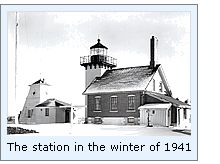 Soon after taking over the station, Stanley began to
experience problems with the lens clockworks, having to pay for a
Sturgeons Bay clockmaker to make the trip to station in an attempt to
effect repairs. In 1884, Keeper Stanley's niece Minnie Hesh arrived at
the station from New York to spend some time with the Stanleys at the
station while recovering from the sudden death or her parent. Evidently
finding the area to her liking, Minnie decided to take up residence in
the area, and eventually married William Cochems, the son of a prominent
Sturgeons Bay businessman in 1889. Soon after taking over the station, Stanley began to
experience problems with the lens clockworks, having to pay for a
Sturgeons Bay clockmaker to make the trip to station in an attempt to
effect repairs. In 1884, Keeper Stanley's niece Minnie Hesh arrived at
the station from New York to spend some time with the Stanleys at the
station while recovering from the sudden death or her parent. Evidently
finding the area to her liking, Minnie decided to take up residence in
the area, and eventually married William Cochems, the son of a prominent
Sturgeons Bay businessman in 1889.
After seven years of supplying the station through the
time consuming process of lightering from anchored supply tenders to
Sawyers Harbor and thence along the rough half mile trail to the
lighthouse, District engineer Major William Ludlow requested a the sum
of $100 to purchase a small parcel of land adjacent to the station on
which he planned to erect a landing crib and stairs leading up the bluff
to the station. Concurring with the need, Congress appropriated the
requested sum on August 30, 1899, and steps were undertaken to obtain
title to the selected parcel. Stanley's problems with the lens became so
well known in the area, that on October 4, 1890 the Door County Advocate
took up Stanleys cause, commenting that he had "no end of
trouble since entering his duties down there to make the thing work at
all times, it being frequently necessary for him or an assistant to move
the machinery by hand." Clear title to the required land was
finally obtained on September 17, 1891, and a crew arrived at the
station that season to erect the necessary cribs and stairs for the
delivery of supplies.
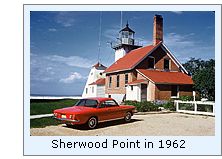 That winter, the decision was made to establish a fog
signal at the station to serve mariners making their way into the canal
entrance in thick and foggy weather. To this end, in the Spring of 1892,
a work crew was dispatched from Detroit to erect a square timber-framed
pyramidal structure to house the new fog bell at the upper edge of the
bluff in front of the lighthouse tower. Sheathed in horizontal siding,
the structure featured a shingled roof and four diamond-shaped windows
on the upper walls to allow light into the building's interior. A
600-pound bronze bell was attached to the lakeward wall of the structure
and an automated
bell striking mechanism within the structure and connected to a
hammer which was hinged to strike the bell on the outer wall through an
opening in the wall. Similar to the lens rotation mechanism, the bell
striker consisted of a clockwork motor, and required winding every four
hours when the bell was in operation ringing out its characteristic
single strike every 12 seconds. To make the new tower match the
appearance of the existing structures, the lower section of the tower
was painted a dark buff color and the upper section slate gray. Work on
the tower was completed, and the new fog bell placed officially into
operation on July 1, 1892. That winter, the decision was made to establish a fog
signal at the station to serve mariners making their way into the canal
entrance in thick and foggy weather. To this end, in the Spring of 1892,
a work crew was dispatched from Detroit to erect a square timber-framed
pyramidal structure to house the new fog bell at the upper edge of the
bluff in front of the lighthouse tower. Sheathed in horizontal siding,
the structure featured a shingled roof and four diamond-shaped windows
on the upper walls to allow light into the building's interior. A
600-pound bronze bell was attached to the lakeward wall of the structure
and an automated
bell striking mechanism within the structure and connected to a
hammer which was hinged to strike the bell on the outer wall through an
opening in the wall. Similar to the lens rotation mechanism, the bell
striker consisted of a clockwork motor, and required winding every four
hours when the bell was in operation ringing out its characteristic
single strike every 12 seconds. To make the new tower match the
appearance of the existing structures, the lower section of the tower
was painted a dark buff color and the upper section slate gray. Work on
the tower was completed, and the new fog bell placed officially into
operation on July 1, 1892.
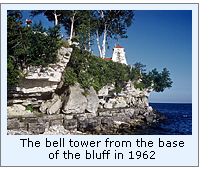 By 1894, Stanley was 70 years old, and responsible for
both a difficult lighting apparatus and a fog signal, he managed to
convince Ninth District Inspector Commander John J. Brice that an
assistant was needed at the station to keep up with the increased
workload. Stanley likely pulled some strings to have his niece Minnie's
husband William appointed to the position, and Minnie and William
Cochems moved into the station with the Stanleys on November 10, 1894.
After suffering from illness for almost a year, Stanley passed away on
October 13, 1895. Surprisingly, a few weeks thereafter Cochems was
promoted to the position of Keeper of the Sherwood Point Light and
Katherine Stanley was appointed as his assistant. By 1894, Stanley was 70 years old, and responsible for
both a difficult lighting apparatus and a fog signal, he managed to
convince Ninth District Inspector Commander John J. Brice that an
assistant was needed at the station to keep up with the increased
workload. Stanley likely pulled some strings to have his niece Minnie's
husband William appointed to the position, and Minnie and William
Cochems moved into the station with the Stanleys on November 10, 1894.
After suffering from illness for almost a year, Stanley passed away on
October 13, 1895. Surprisingly, a few weeks thereafter Cochems was
promoted to the position of Keeper of the Sherwood Point Light and
Katherine Stanley was appointed as his assistant.
Evidently, Cochems continued to experience problems
with the operation of the lens rotating mechanism, as the Ninth District
Lampist arrived at the station on March 23, 1898, and replaced the
entire lens, pedestal and rotating mechanism with the illuminating
apparatus previously installed at the Passage
Island light, along with a new ball bearing rotating mechanism.
Deciding to retire from lighthouse service, Katherine Stanley resigned
her position on June 24 of this same year, and Minnie Cochems was
appointed to replace her on Katherine's departure, and William and
Minnie had the lighthouse to themselves and their children, and took
great pride in maintaining the lighthouse grounds in pristine condition.
Since the earliest days of the US lighthouse service,
lard and sperm oil ware used for fueling the lamps. Relatively
non-volatile, the oil was stored in special rooms in lighthouse cellars
or in the dwelling itself. With a change to the significantly more
volatile kerosene, a number of devastating dwelling fires were
experienced, and beginning late in the 1880's the Lighthouse Board began
building separate oil storage buildings at all US light stations. As a
result, it was surprising that the Sturgeon Point light was never
equipped with a separate oil storage building . This situation was
rectified in 1902 when a work crew and materials were delivered at the
station and a brick oil storage building was erected a safe distance
from the main building. Three years later, another crew arrived at the
station and replaced all of the timber walkways with concrete. The
district Lampist returned to the station on April 25, 1917 and upgraded
the lamp to an incandescent oil vapor system, thereby increasing the
output of the fixed white light to 1,700 candlepower and the red flash
to 4,300 candlepower.
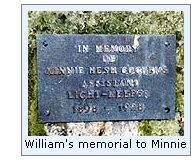 As Minnie was getting out of bed on August 17, 1928,
she collapsed and passed away. In tribute to his late wife, William
placed a plaque on a stone pedestal in the garden to the east of the
station which read "In memory of Minnie Hesh Cochems, Assistant
Light-Keeper, 1898 - 1928." With the arrival of electrical
power in the area, the station and light were electrified in 1930. After
Minnie's death, the position of assistant at the station was never
refilled, and this may have served as a contributing factor to William's
decision to retire from lighthouse service three years later on July 1,
1933 after almost 39 years of service at the station. As Minnie was getting out of bed on August 17, 1928,
she collapsed and passed away. In tribute to his late wife, William
placed a plaque on a stone pedestal in the garden to the east of the
station which read "In memory of Minnie Hesh Cochems, Assistant
Light-Keeper, 1898 - 1928." With the arrival of electrical
power in the area, the station and light were electrified in 1930. After
Minnie's death, the position of assistant at the station was never
refilled, and this may have served as a contributing factor to William's
decision to retire from lighthouse service three years later on July 1,
1933 after almost 39 years of service at the station.
Conrad Stram was transferred to Sherwood Point from
the Sturgeon Bay Canal
light where he had served for the past six years. With
establishment of the automated Peshtigo
Reef light on August 26, 1935, supervision, maintenance and
operation of the new light were added to Stram's responsibilities.
However, Stram would be required to operate both lights and the fog
signal single-handedly. With plans for the establishment of a
radiobeacon at the station for 1940, First and Second Assistant's were
assigned to the station in 1939. With the Coast Guard's assumption of
responsibility for the nation's aids to navigation in 1939, the civilian
keepers were given the alternative of either transferring into the Cost
Guard or maintaining their civilian status, which was the alternative
chosen by Stram.
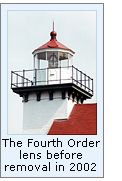 The fog signal was automated in 1940 through the
installation of electrically-operated diaphragm horns, and with the
automated bell ringing apparatus removed, the bell tower was converted
into a radio room. The following year, Stram changed his mind, and
transferred into the Coast Guard, and continued to serve as keeper of
the Sherwood Point Light until he retired in 1945. The fog signal was automated in 1940 through the
installation of electrically-operated diaphragm horns, and with the
automated bell ringing apparatus removed, the bell tower was converted
into a radio room. The following year, Stram changed his mind, and
transferred into the Coast Guard, and continued to serve as keeper of
the Sherwood Point Light until he retired in 1945.
Coast Guard crews continued to man the Sherwood Point
station through the fall of 1983, when the light was the last on the
Great Lakes to be automated. With the litharge which held the lens
prisms in place found to be significantly deteriorated as a result of
constant exposure to the sun's ultraviolet rays and a lack of daily
maintenance by full time keepers, the Fresnel lens was removed from the
lantern on October 21, 2002 and replaced by a 300
mm acrylic optic. The historic Fourth Order lens was transported
to the Door County Maritime Museum where it was restored by Coast Guard
Lampist Jim Woodward, and can currently be seen on display.

Keepers of
this Light

Click Here to see a complete listing of
all Sherwood Point Light keepers compiled by Phyllis L. Tag of Great
Lakes Lighthouse Research.

Finding this
light

This lighthouse is currently private Coast Guard property, and as such all access
is closed to the public. We obtained specific permission from the Coast
Guard to enter the grounds and take photographs for this website.
However, the station is open to the public every year during the annual Door County Lighthouse Walk
which is held in mid May every year.
Click
here to use the Museum's web-based brochure request form, or
contact the Museum at:
The Door County
Maritime Museum
120 N. Madison St.
Sturgeon Bay, WI 54235
(920) 743-5958

Reference Sources

Annual Reports of the Lighthouse
Board, Various, 1880 - 1909
Annual reports of the Commissioner of Lighthouses, 1910 - 1939
Engineers survey of the station, 1886
Annual reports of the Lake Carriers Association, 1906 - 1935
Door County Advocate, various, 1880 - 1920
Great Lakes Light Lists, various, 1886 - 1979Personal observation at Sherwood Point, 09/10/2000
Keeper listings for this light appear courtesy of Great
Lakes Lighthouse Research
|
